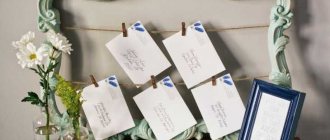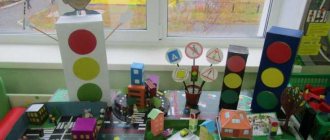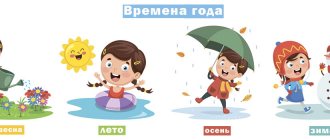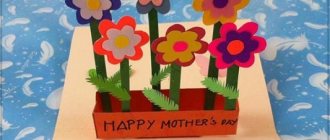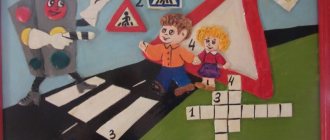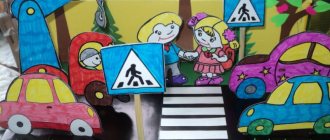Every interested parent goes through the experience of decorating children's themed corners with their own hands. The pets themselves and teachers participate in the creation of this mandatory element of the interior in preschool and school institutions.
The items that make up the composition can be crafts made during classes or specially selected items (souvenirs, printed materials) that have developmental significance.
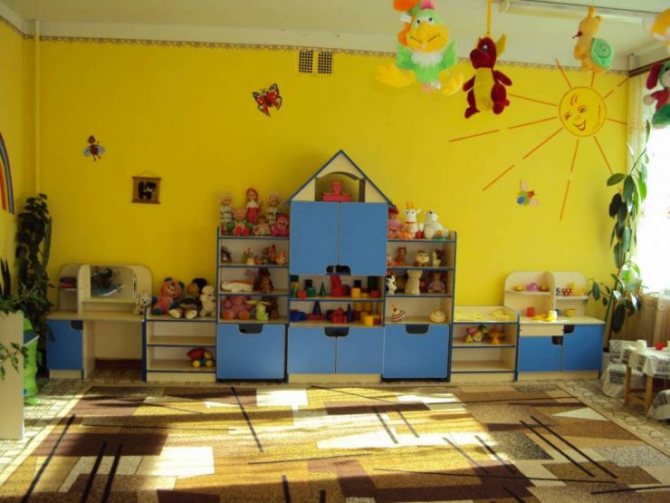
In kindergarten and elementary grades, parents can also be involved in equipping the corners. Their indirect participation is also implied at subsequent stages of study, when students, having received an appropriate creative task, turn to family members for help.
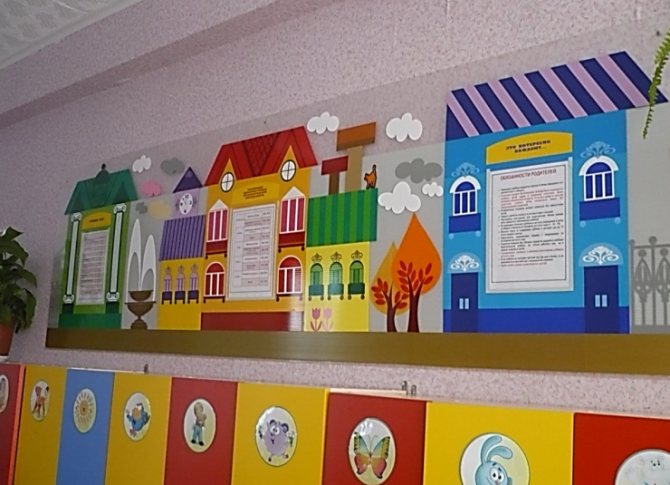
Interior features in kindergarten
Decorating rooms for games and activities allows you to zoning the space and optimally use visual attributes in the process of raising and developing a child.
Thematic exhibitions with crafts and drawings complement the theme of the matinees; they can change in accordance with the seasons and holiday dates.
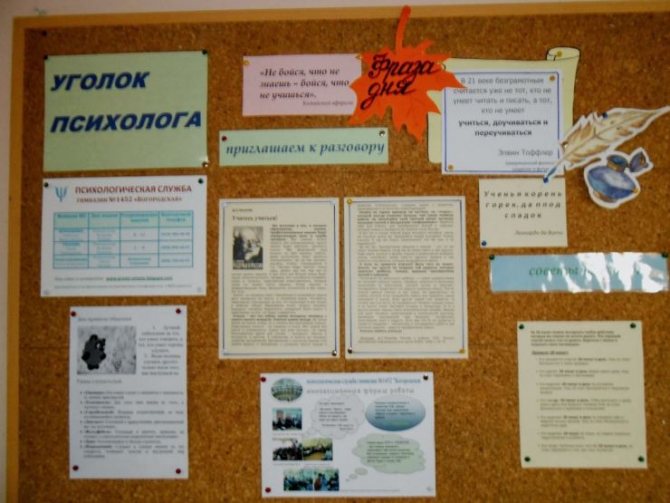
To create an exhibition board for drawings, the most suitable material is considered to be a lightweight cork sheet on which the paper can be fixed using buttons. It can be rectangular or with a curly cut.
The cork board is installed on a wooden, plastic or aluminum frame, which is firmly fixed to the wall. The surface of the stand can be painted or decorated with figures made of self-adhesive paper.

To create a display board, the content of which is updated daily, you can use a frame with stretched fabric, while the drawings are secured with safety pins.
Making your own passe-partout and special pockets for paper is an integral part of decorating corners in kindergarten.

The ability to abandon buttons and other metal fasteners will protect children and they will be able to change exhibits on their own.
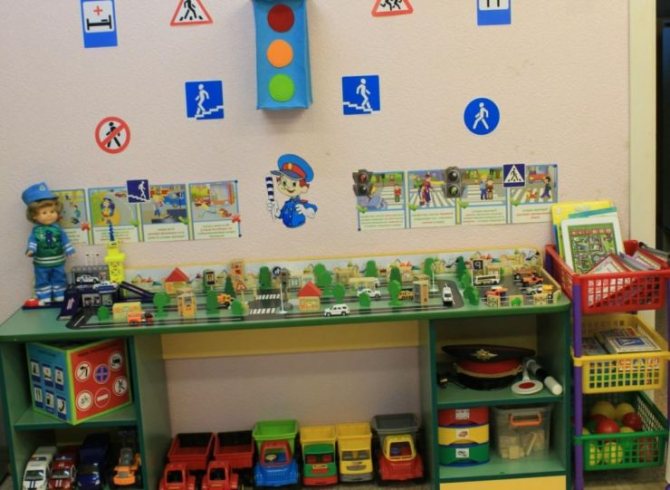
To place bulky crafts, it is convenient to use narrow wall shelves. You can creatively add images of fairy-tale characters in poses supporting stands for figurines made by children into the background of the design.
Organization of a subject-developmental environment in the junior group of preschool educational institutions according to the Federal State Educational Standard
Organization of a subject-developmental environment in the younger group
Author : Olga Vladimirovna Bobkova, Educator of MBDOU kindergarten No. 4 “Fairy Tale”. Description : my methodological development will be useful to kindergarten teachers; in my work I described in detail how to design the environment of the junior group so that it complies with the Federal State Educational Standard, develops children and reveals their individuality.

Among it, the child will live - develop his own self-sufficient life, his spiritual growth will be improved from himself, from nature... E. I. Tikheyeva One of the important conditions for educational work in a preschool institution is the correct organization of the subject-developmental environment.
A properly organized developmental environment will allow each child to find something they like, to believe in their strengths and abilities, to learn to interact with teachers and peers, to understand and evaluate their feelings and actions, and this is precisely what lies at the heart of developmental education. The developing subject environment is the main means of shaping the child’s personality and is the source of his knowledge and social experience. The environment surrounding children in kindergarten should ensure the safety of their lives, promote health and strengthen the body of each of them. The organization of a subject-developmental environment in a kindergarten carries the effectiveness of educational influence aimed at developing in children an active cognitive attitude towards the surrounding world of objects, people, and nature. It should be formed taking into account certain principles developed in the works of leading teachers, in particular, taking into account the age of the children, since each age group has its own specific psychological and pedagogical characteristics. When creating a subject-development environment in the second younger group, we relied on the principle of activity , stability, flexible zoning. The group has created conditions for children to interact with the teacher and with each other. There is also a corner of solitude, which gives the child a sense of psychological security and helps personal development. We try to enrich the environment with elements that would stimulate the cognitive, developmental, motor and other activities of children. The content of the subject-development environment corresponds to the interests of boys and girls, periodically changes, varies, and is constantly enriched. Functions of the subject-development environment in the younger group: Cognitive – satisfies the child’s need to master the world around him, stimulates cognitive activity; Communicative – stimulates speech development, allows the child to learn the basics of communication and interaction; Wellness – stimulates motor activity, enriches motor experience, introduces to the culture of health; Creative – introduces children to creative activities, promotes self-development and self-realization. In our group, the subject-development environment is divided into micro-centers for children’s independent activities: Center for role-playing games. Objectives: to promote the emergence of the game; develop the ability to choose a role and perform several interrelated actions in the game; formation of communication skills in the game; development of imitation and creative abilities. Learn to use building materials in games. Equipment and materials that we have in our corner: doll furniture for the room and kitchen; ironing board; attributes for playing “House”, “Shop”, “Barbershop”, “Hospital”, “Drivers”, etc.; dolls; toy wild and domestic animals; sets of kitchen and tea utensils; a set of vegetables and fruits; large and medium-sized cars; trucks and cars; telephone, steering wheel, scales, bags, buckets, iron, hammer, etc.; doll strollers; fun toys; clothing for dressing up. The main activity of our kids is play. The playroom contains toys that introduce children to the everyday objects around them. Kids get acquainted with objects that are new to them and learn to operate with them. The acquired knowledge and skills are transferred to everyday life. Nature Center: Objectives: Environmental education and education of children. Foster love and respect for nature. Physical Culture Center: Objectives: To create conditions for physical exercise in a group, to stimulate children’s desire to engage in physical activity. To instill in children a conscious attitude towards their health. Strengthening the muscles of the lower and upper extremities, preventing flat feet; prevention of colds; strengthening the muscles of the spinal column, preventing scoliosis. Equipment and materials that we have in our corner: rugs, massage paths, with footprints (to prevent flat feet); gymnastic sticks; balls; hoops; jump ropes; skittles; cubes; balls, handkerchiefs, long and short cord; bags with cargo; ribbons of different colors; checkboxes; attributes for outdoor games and morning exercises. The need for movement is an important task when organizing a subject-development environment.
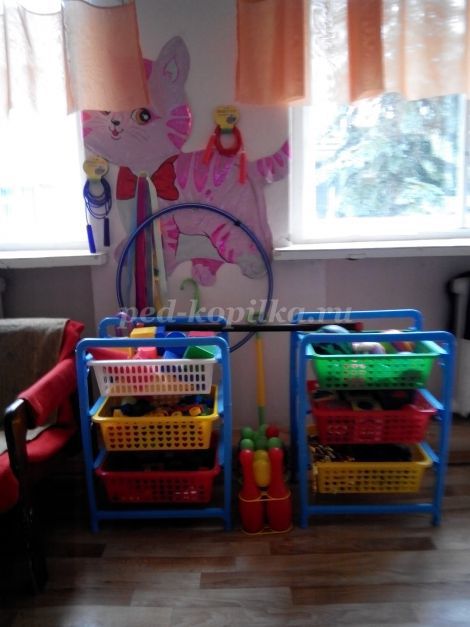


Center for sensory and speech development.

Objectives: Performs a calming and relaxing function. The child can relax, be alone with himself, play educational games, watch a book or just dream. Reducing the level of anxiety, psychological stress, improving mood. Materials and equipment: A jar of “Aggression”, a mirror, games “Emotions”, “My Mood”, a box “Mirilochka”, chairs for bad and good moods, family photo albums, soft toys, handmade toys, pebbles. A properly organized developmental environment allows every child to find something they like, to believe in their strengths and abilities, to learn to interact with teachers and peers, to understand and evaluate their feelings and actions, and this is precisely what lies at the heart of developmental education. The subject-developmental environment of the group is as close as possible to the interests and needs of each preschooler. We tried to ensure that the child had the opportunity to do what he loved in the mini corner of his choice. Everything in the group is accessible to every child, is age appropriate and takes into account their individual characteristics and developmental capabilities. Conditions have been created for the accumulation of creative experience, the application of one’s knowledge and skills, in situations of action with familiar or completely unfamiliar objects. The subject-spatial environment of the group creates a comfortable mood and promotes the emotional well-being of children.
We recommend watching:
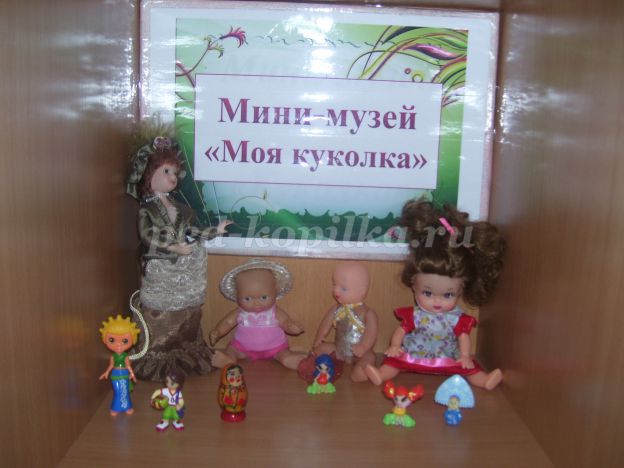
Mini-museums in my kindergarten group Federal State Educational Standard in preschool education Curriculum of MBDOU in accordance with the Federal State Educational Standard for preschool education Round table in a preschool educational institution in accordance with the Federal State Educational Standard
Similar articles:
Do-it-yourself group decoration in kindergarten
DIY Autumn panel
A corner to connect with nature
The concept of decorating a corner of nature with your own hands depends on the age group and the ability to regularly care for the exhibits.

If the exhibit will be within reach of children, it should include only harmless items.
You can create a model of a farm or savannah with plastic figures. Nearby you can place cards with images of animals, insects and plants.
For children who can take part in watering and care, you can create a picturesque corner with climbing and exotic plants.

Nearby on the windowsill you can set up an indoor vegetable garden for germinating seeds.
As additional attributes, you can use temperature and humidity sensors, spray bottles and water containers, special cloths for cleaning plants, and spatulas for loosening.
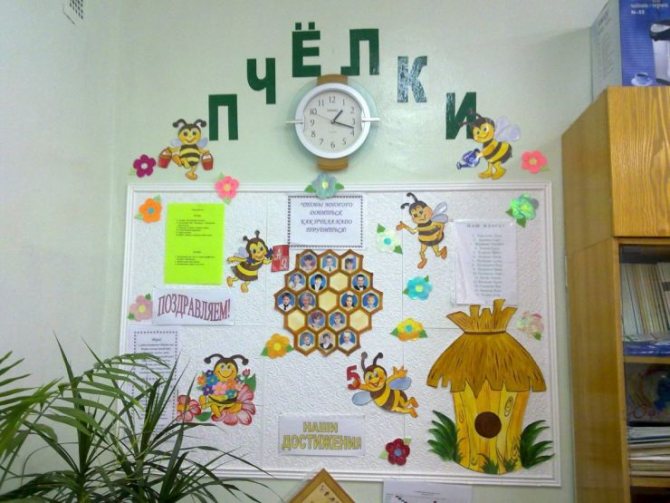
You can use tree bark, pine cones, and herbariums to decorate the corner. In the common playroom, if regular specialized care is possible, you can also place an aquarium with fish.

Corners and centers in groups - Corner of solitude in the early childhood development group
Publication “A corner of solitude in an early development group...” The corner of solitude in our group is intended to form the psychological stability of the child. During the adaptation period, young children are very susceptible to mood changes, because they still know very little about themselves and do not know how to control themselves. A corner of solitude is a place where can a child...
Image library "MAAM-pictures"
Familiarization with the natural world “Duty in a corner of nature” Age: 4-5 years Objectives: Educational: To consolidate children’s knowledge and skills in caring for plants in a corner of nature. Educational: To develop responsibility for the assigned task and the ability to bring it to the end. To cultivate a love and interest in plants, a desire to care for them,…
Design corner for older preschoolers Design corner for older preschoolers Currently, experts in the field of pedagogy and psychology pay special attention to children's design. It is believed that this type of activity fully meets the interests of children, their abilities and capabilities. Under…
Master class “Making a model “Winter fun” for a corner of nature in the second junior group”
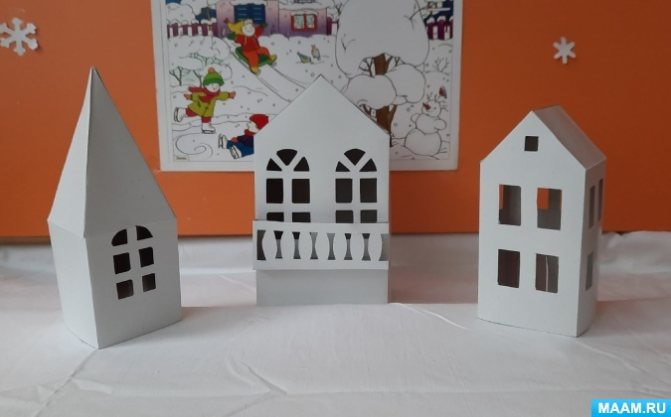
In the 2nd junior group, the nature corner should be equipped with the necessary aids that expand children’s understanding of living and inanimate nature, and the seasons. One of them is the “Winter Fun” model, made by yourself. For this purpose, houses with window slots were glued together from cardboard:...
Rack for sports equipment
Decorating a sports corner with your own hands is done in the active games area. For bright hoops, clubs, balls and jumping ropes, it is necessary to organize aesthetic and convenient storage with special holders, nets and shelves.

To equip the corner, you need to use the safest plastic or fabric products.
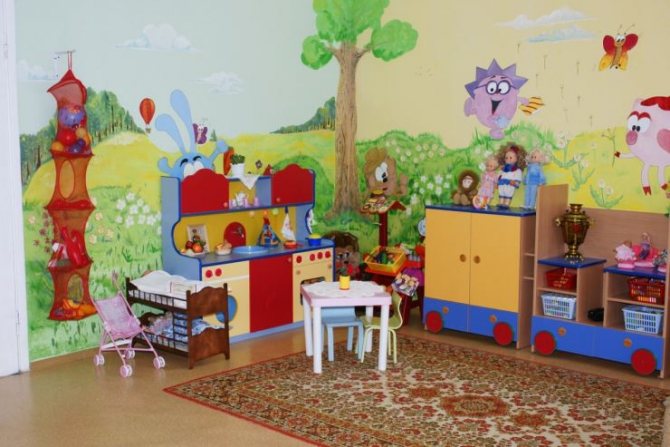
The contents of the exhibition can be supplemented with homemade items, such as fake fishing rods or other devices for developing dexterity.
Junior group. Early childhood, nursery. Children 1-4 years old
Traffic rules corner for the little ones for an early age Traffic rules corner for the little ones (early ages)
Galiullina Elvira Kamilevna Goal: To develop basic knowledge about the rules of safe behavior on the road. Objectives: 1. Teach children to recognize traffic lights: red and green. Form a stable idea of...
Model of a corner for sensory development for children from 1 to 3 years Age group : from 1 to 3 years Purpose: Formation of sensory abilities in children 1-3 years old in a preschool setting. Objectives: 1. continue to develop logical thinking in children. To form general sensory ability, i.e. ability to use sensory standards (5 colors of the spectrum,...
Information board in children's institutions
When decorating a corner for parents with your own hands, the overall aesthetics of the institution are preserved.
The composition, as a rule, is placed in the reception area, the most optimal place is above the changing lockers or at the entrance to the room. A section of the wall is decorated with bright, cheerful drawings or wall relief figures, the details of which can be supplemented with seasonal or festive elements.
Subject developmental compositions in kindergartens
Exhibits with special paraphernalia on traffic rules, hygiene and healthy eating, shelves with musical instruments, books or pencils are also located in separate areas with a thematic design.
According to the requirements of modern pedagogy, privacy zones can also be created in playrooms and classrooms - houses, tents, curtained areas with upholstered furniture.
In the process of decorating corners with your own hands, you can use photo collections with successful solutions.



